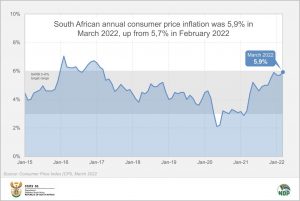Transport costs continue to drive inflation higher
Annual consumer price inflation quickened to 5,9% in March from 5,7% in February, placing it just below the upper limit (6%) of the South African Reserve Bank’s monetary policy target range. Transport, housing and utilities, and food and non-alcoholic beverages were the most significant contributors, with transport contributing 2,1 percentage points to the annual rate.
The monthly change in the index was 1,0% in March, up from 0,6% in February.
This consumer price index (CPI) release is the third to be compiled using the recently updated weights and basket of goods and services.1 The price indices have also been rebased so that December 2021 = 100.2
Fuel prices and other transport costs continue to rise
Fuel prices increased by 7,2% between February and March, with inland 95-octane petrol rising by R1,46 per litre to reach a record high of R21,60 per litre.3 Fuel prices rose by an eye-watering 33,2% in the twelve months to March, with petrol prices climbing by 32,6% and diesel by 35,1%.
The transport index in March was also driven higher by increases in toll fees, air transport and bus fares.
Food and non-alcoholic beverages (NAB) inflation moderates slightly
Food and NAB inflation was softer in March. The monthly rate slowed from 0,9% in February to 0,6%, and the annual rate from 6,4% to 6,2%.
Bread and cereal prices increased at a monthly rate of 1,1% in March after recording a 2,4% jump in February. Other food categories in the CPI basket that registered price increases between February and March include meat; milk, eggs and cheese; fish; and sugar, sweets and desserts.
After rising for three months in a row, prices for oils and fats edged lower in March, dipping slightly by 0,1%. Despite a 0,7% decline in the price of sunflower oil, it is 27% more expensive than a year ago.
Fruit and vegetable prices also dipped lower. After increasing for five consecutive months, fruit prices dropped by 1,3% between February and March. Vegetable prices edged lower by 0,4%, with decreases recorded for lettuce, mushrooms, dried beans, tomatoes, onions, potatoes and sweet potatoes.
Other notable price changes
The March release of the CPI incorporates adjustments to excise duties and includes the latest data from rentals and education fees. A rise in excise duties came into effect, contributing to a 2,2% monthly jump in alcohol and tobacco prices. The most recent results of the quarterly rental survey recorded a rise of 0,6% in both actual and imputed rentals compared with the previous quarter.
Stats SA surveys educational institutions and crèches once a year in March. After dropping to a 30-year low of 4,1% in 20214, annual education inflation edged higher to 4,4% in 2022. Primary and secondary school fees increased by 4,5% and tertiary fees rose by 4,2%.
For more information, download the March 2022 CPI statistical release here.
1 For more information on the recent reweighting and rebasing exercise, see the information note here.
2 See Figure 1 and Table B1 in the March 2022 CPI statistical release for the headline index.
3 Department of Mineral Resources and Energy. Comparing prices for petrol, diesel and illuminating paraffin (IP) (click here).
4 Stats SA, Education inflation the lowest in 30 years (read here).
Similar articles are available on the Stats SA website and can be accessed here.
For a monthly overview of economic indicators and infographics, catch the latest edition of the Stats Biz newsletter here.


